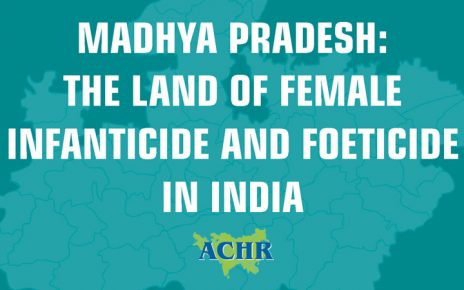Among the States and Union Territories (UTs) of India, Delhi has the 4th worst record of Child Sex Ratio (CSR) as per 2011 census. The CSR of Delhi declined sharply by 47 points from 915 in 1991 census to 868 during 2001 census. It showed marginal recovery by 3 points to 871 during 2011 census but still way behind the national level CSR of 919 during 2011 census. While in 1991, all the nine districts of Delhi had CSR above 900 but as per 2011 census, the Central district was the only district to record CSR above 900.
The Sex Ratio at Birth (SRB), which gives more accurate picture of sex selection, drastically came down from 867 females per 1000 males in 1991 to 809 females by 2001. The situation reversed in 2008 with an unprecedented birth of 1004 females per 1000 males. The Government of NCT of Delhi claimed success “due to implementation of girl child related welfare scheme, particularly Ladli Scheme implemented with effect from 01/01/2008”. But in the following year (2009) the SRB fell sharply by 89 points to 915 and further dropped to 901 in 2010, 893 in 2011 and 886 in 2012 while it marginally improved to 895 in 2013, 896 in 2014 and 898 in 2015. None claimed responsibility for the fall in the SRB in all these years. If the existing under-five mortality rate of 48 deaths per 1,000 births in India is applied in the context of NCT of Delhi, the CSR will further drastically fall below 871 as per 2011 census.
There is little seriousness on the part of the Government of NCT of Delhi to address female foeticide leading to skewed sex ratio.
The SRB of Delhi indicates that the Ladli Scheme, the main programme of the Government of NCT of Delhi for retention of the girl child, has not been having the desired impact as summarized below:
First, as per the Comptroller and Auditor General (CAG) of India, “the [Ladli] scheme was launched without having data of intended beneficiaries to be covered under the scheme and without fixing any annual target, financial or physical” and without identifying the roles of stakeholders viz. Department of Education, Department of Social Welfare and Department of Health.
Second, the primary targets of the Ladli Scheme are the socially and economically backward sections of society i.e. those below the poverty line. However, son preference cuts across economic barriers and indeed, those financially well-off have the capacity to engage more in sex selection than the poor. With 90% of the population of Delhi being Above Poverty Line (APL) families as per the latest Economic Survey of Delhi tabled in the Delhi Assembly on 24 June 2015, about 90% of the population are indeed excluded from the Ladli scheme.
Third, the requirement of renewal of the scheme at each milestone i.e. at the time of birth and admissions in different classes i.e. Class I, VI, IX, X and XII had been found to be so cumbersome that many dropped out of the scheme. As per the report of the CAG, about 42% of beneficiary girls were dropped from the Ladli Scheme due to non-renewal of their cases at different stages during 2010-11 to 2011-12. Out of 1,25,808 cases due for renewal, only 73,108 cases i.e. 58.11% were renewed as of October 2012.
Fourth, out of those who went through the cumbersome procedure to renew the scheme and reach maturity, as per the CAG, about 43% of beneficiaries were deprived of the benefits after maturity during 2009-2012. Out of 51,835 cases of maturity only 29,800 (57%) were finalised and the rest i.e. 43% of beneficiaries were deprived of the benefits even after maturity during 20092012 because of the failure of the Government of NCT of Delhi to finalise their maturity claims.
The CAG’s findings make it clear that intended enabling provisions of the Ladli Scheme have in fact ended up disabling the girl child.
Considering that the Ladli scheme does not cover about 90% of the population of Delhi and it has effectively failed, the retention of girl child and increase in the CSR equally depended on the robust implementation of the Preconception and Pre-Natal Diagnostic Techniques (Prohibition of Sex Selection) Act, 1994. There are regular reports of sex selection but cases registered are few and cases resulting into conviction are fewer.
The National Crime Records Bureau reported registration of 38 cases of foeticide in Delhi during 2005 to 2014. However, there was only one conviction under the PC&PNDT Act from 2009 to September 2014. On 4 March 2013, the Supreme Court in Voluntary Health Association of Punjab vs. Union of India & Ors, 15 directed among others, to various courts in the country through the Registrars of various High Courts to “take steps to dispose of all pending cases under the Act, within a period of six months”. As per information placed before the Parliament by the Ministry of Health and Family Welfare, six more convictions took place in NCT of Delhi in 2015. On the other hand, in 2014 alone, the Health department cancelled registrations of 43 radiologists and clinics and sealed 11 ultra sonography machines for conducting sex determination of foetuses. The gap between actual number of offences committed under the PC&PNDT Act, the number of cases registered and number of convictions is one of the root causes for declining CSR in Delhi.
Further, the concerns about the abuse of the Medical Termination of Pregnancy (MTP) Act of 1971 for sex selective abortion are not misplaced. The All India Institute of Medical Sciences (AIIMS) after examining 238 aborted foetuses and newborns abandoned in different parts of affluent South Delhi and brought to the AIIMS between 1996 and 2012 found that females outnumbered males among fetuses that were less than or equal to 20 weeks of gestational age, clearly suggesting sex-selective abortions. The study opined that it was quite possible that some of these foetuses were aborted after tests revealed the foetuses to be female.
The failure of the Delhi Ladli scheme and the lack of proper implementation of the PC&PNDT Act and the MTP Act have had cascading effect on the CSR in NCT of Delhi. On 10 October 2015, the Government of NCT of Delhi issued show cause notices to 89 hospitals and nursing homes whose SRB ranged from 285:1000 (Female: Male) to 788:1000 during 2014-2015 and were suspected of “carrying female foeticide”. The notices were ludicrous – considering the abnormal SRB, the government should have ordered appropriate inquiries under the PC&PNDT Act instead of seeking responses. No institution shall ever admit criminal offences – and not surprisingly, hospitals and nursing homes blamed god, luck, poverty etc for low sex ratio in their responses to the Government of NCT of Delhi.
The lack of commitment of the Government of NCT of Delhi to enforce the PC&PNDT Act stands exposed from the failure to update the status of cases registered under the PC&PNDT Act since 2015. In its RTI reply dated 13.12.2016, the Directorate of Family Welfare, Government of Delhi provided the list of the 77 cases registered by 2014 apparently prepared for submission before the Supreme Court in Voluntary Health Association of Punjab vs. Union of India & Ors. Though in October 2015, the Government of the NCT of Delhi announced its plan to reward those providing information about those conducting illegal sex determination, no such scheme has been launched as on date.
Conclusion and recommendations
The situation of Delhi reflects India’s losing battle against female foeticide across the country. The Government of NCT of Delhi ought to learn from the available best practices on the issue and improve its action for retention of girl child.
Asian Centre for Human Rights recommends the following to the Government of National Capital Territory of Delhi:
Ladli Scheme
- Revise the Delhi Ladli Scheme to increase the amount for post birth benefits of at least Rs. 1 lakh, provide educational scholarship of Rs. 50,000 and further additional financial assistance of Rs. 1 lakh to be paid to surviving girls for assistance during marriage;
- Expand the coverage of the Delhi Ladli Scheme to include all girl children of Delhi irrespective of income of their parents or place of birth and benefits be provided to all the girl children in the family;
- Issue necessary order to restore the benefits of the Delhi Ladli Scheme to all beneficiaries including the 52,700 cases identified by the Comptroller and Auditor General (CAG) during 2010-11 to 2011-12 which were dropped from the Delhi Ladli Scheme due to non-renewal of their cases at different stages;
- Amend the guidelines of the Delhi Ladli Scheme by removing the necessity to renew the application at different stages;
- Link the Delhi Ladli Scheme with all Anganwadi Centres and Schools including the private schools where about 25% of the seats are required to be reserved for the economically weaker sections;
- Undertake specific programme for increasing coverage of all families under the Delhi Ladli Scheme by connecting the programme with all hospitals/nursing homes/primary health centres;
- Digitise the funds sanctioned and utilization certificates and upload the same in the website of the Department of Women and Child Development; and
- Renegotiate the Memorandum of Understanding with the State Bank of India Life to fix the rate of interest from the inception of the Delhi Laldi Scheme;
PC&PNDT Act
- Establish PC&PNDT Bureau of Investigation under the Department of Health and Family Welfare to assist the appropriate authorities for effective implementation of the PC&PNDT Act;
- Launch a Mukhbir Yojana to reward those providing information with amount of rewards of at least Rs 200,000 to decoys and Mukhbirs along with (i) specific incentive in the form of bond/scheme for the unborn baby of the decoy customer26 apart from undertaking of not aborting the foetus under any circumstances; (ii) specific allowance to the decoys and Mukhbirs to attend each hearing during the trials; (iii) ensure anonymity of the complainants, informers etc to the extent possible;27 and (iv) sanction adequate financial resources for implementation of the scheme;
- Introduce Integrated Monitoring system for the PC&PNDT Act and installing tracking devices in all sonography machines;
- Ensure proper implementation of the PC&PNDT Act inter alia through: (a) ensuring efficient and effective system of registration of all ultrasound/ genetic clinics so as to ensure compliance to the provisions of the Act; (b) ensuring regular and effective inspection of the ultrasound/ genetic clinics for curbing the violation of Act & Rule; and (c) ensuring proper enforcement mechanism and taking appropriate action for violations of the provisions of Act;
- Ensure time bound trial of the cases under the PC&PNDT Act; and
- Make necessary budgetary allocations for implementation of all these measures.




